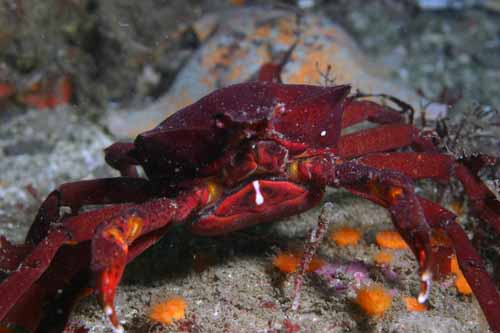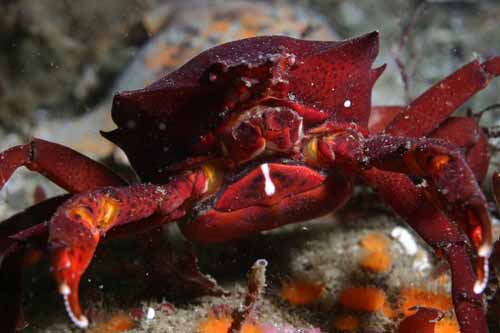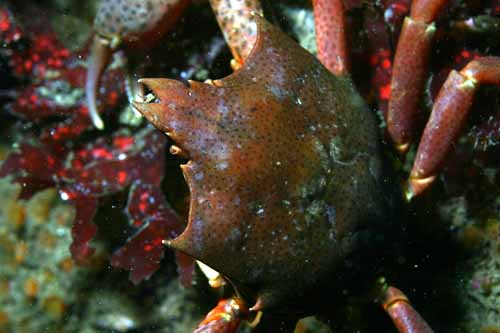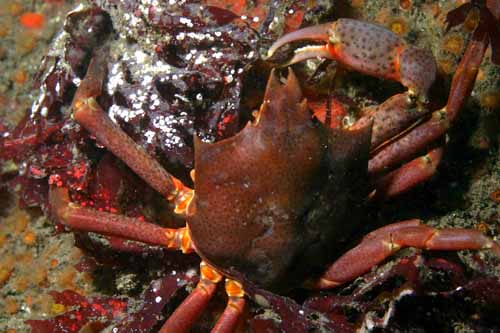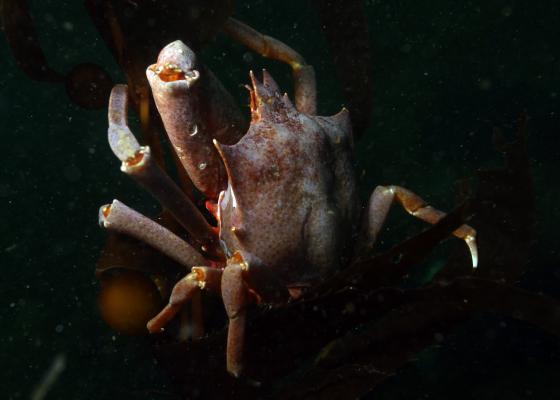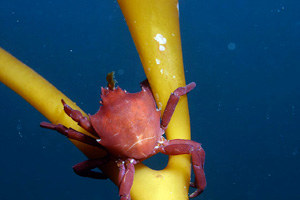
Kelp crab
Pugettia producta
Overview
Key Features:
The carapace of Pugettia producta is broad and smooth, whereas other spider crabs have a hairy carapace that they use to decorate with invertebrates and algae.Similar Species:
Foliate kelp crab (formerly Mimulus) (Pugettia foliata)Primary Common Name:
Kelp crabGeneral Grouping:
Crabs, barnacles, shrimp, lobsterGeographic Range:
Yakutat, Alaska to Punta Asuncion, Baja California, Mexico
Pugettia producta can be found from Yakutat, Alaska to Punta Asuncion, Baja California, Mexico.Intertidal Height:
-2 to 0 feet (-0.6096 to 0 meters)Notes:
Juvenile Pugettia producta is found in the low intertidal and in tidepools.Subtidal Depth Range:
Minimum Depth: 0 meters or 0 feetMaximum Depth: 15 meters or 0 feet
Notes:
Either found on a rocky bottom or climbing the giant kelp Macrocystis pyrifera.Habitats:
exposed rocky shore, kelp forest, protected rocky shoreNotes:
Adult Pugettia producta lives mostly in kelp beds but is also common on wharf pilings. Juveniles are found more often intertidally, around surfgrass or under rocks. This crab can be found from the intertidal to about 73 meters in depth.Abundance:
Relative Abundance:
CommonSpecies Description:
General:
Pugettia producta belongs to the class Crustacea and the family Majidae, which is the spider crab family. Spider crabs are named for their spindly legs, but also known as masking crabs due to their habit of camouflaging themselves with bits of algae, sponges, bryozoans, or other material. While many of Pugettia producta's family members exhibit this behavior, Pugettia producta does not. This may be due to the fact that Pugettia producta is moderately active, faster moving, and larger than most spider crabs and therefore does not need as much camouflaging protection. Pugettia producta that live on wharf pilings may have a few barnacles or anemones growing on its carapace. Also, it does have two rows of hooked setae just behind its rostrum, to which it sometimes attaches algae. Although, the items it attaches may be mainly food, which it detaches and eats later.Distinctive Features:
The carapace of Pugettia producta is broad and smooth and not as hairy as other spider crabs. The rostrum is relatively short. The distance between the eye sockets is 1/3 the total width of the carapace, which is relatively closer together compared to other spider crabs. There is a prominent spine on each side of the carapace, and 2 more strong spines toward the rear end. The color of the carapace can be olive or reddish-brown with darker dots and the underside is yellow or scarlet. Juveniles have red or olive green carapaces. They have equal, moderately sized pincers. They have four pairs of moderately long and slender walking legs. The second pair is the longest being one and a half times the body length. They also have a pair of modified legs called chelipeds. The abdomen has seven segments.Below Point Conception Pugettia producta is joined by the southern kelp crab, Taliepus nuttallii. Taliepus nuttallii can be distinguished by its carapace, which is fairly clean, rounder than Pugettia producta's and often purple with blotches of lighter colors.
Size:
Pugettia producta can grow to be 95 mm wide and 121 mm long. Females are slightly smaller reaching a maximum width of 78 mm.Natural History:
General:
Pugettia producta is called a kelp crab because it occurs so frequently on strands of seaweed and is well adapted to the kelp. The sharp points on its carapace and spines on its legs allow the crab to hold onto seaweed in the face of wave shock. The color of Pugettia producta tends to match the color of the kelp on which it lives and eats, thus acting as a natural camouflage. Since these crabs do not actively decorate themselves, they rely on their aggressive disposition for protection. This crab is relatively thin-shelled and cannot osmoregulate, therefore, it does not tolerate brackish water.Predator(s):
Pugettia producta have a variety of predators, including sea otters, Enhydra lutris, staghorn sculpins, Leptocottus armatus, gulls, and cabezon, Scorpaenichthys marmoratus. Pugettia producta is also often parasitized by a rhizocephalan sacculinid barnacle, Heterosaccus californicus. Pelagic larvae will often be eaten by a cnidarian called by-the-wind sailor, Velella velella.Prey:
Pugettia producta most often eats brown algae, including rockweed, Fucus, giant kelp, Macrocystis, bull kelp, Nereocystis, gulfweed, Sargassum, feather boa kelp, Egregia, winged kelp, and Pterygophora. It may eat green algae, such as sea cabbage, Ulva, and some red algae. This crab will also occasionally feed on barnacles, mussels, hydroids, and bryozoans. It may also feed on lion nudibranches, Melibe leonine.Feeding Behavior:
HerbivoreNotes:
Pugettia producta feeds primarily on algae, only switching to sessile animals when algae are scarce. This crab feeds nocturnally.Seasonal Behavior
September - November
Migration:
In the fall adult Pugettia producta migrate to deeper water where they congregate, feed, and mate.January - December
Reproduction:
Pugettia producta is an impressive breeder since females are capable of producing offspring as often as every 30 days and can carry as many as 61,000 developing eggs. In California, females are found carrying eggs throughout the year and some have been observed mating while still carrying eggs from a previous brood. They copulate by hard-shelled airs. The reddish-orange eggs develop under the female's abdomen and they will stay there for several months. Embryonic development may require nearly a year. Like other spider crabs, Pugettia producta undergoes a terminal molt upon reaching sexual maturity and may thereafter become heavily encrusted with growths of various organisms.References
- Cowles, D. 2005. World Wide Web electronic publication. http://www.rosario.wwc.edu, Accessed [06/02/06].
- Gotshall, D. 2005. Guide to marine invertebrates : Alaska to Baja California. Sea Challengers, Monterey, CA. 117 p.
- Jensen, G.C. 1995. Pacific Coast crabs and shrimps. Sea Challengers, Monterey, CA. 87 p.
- Langstroth, L. and L. Langstroth. 2000. A Living Bay: The Underwater World of Monterey Bay. University of California Press, Berkeley and Los Angeles, CA. 287 p.
- Meinkoth, N.A. 1998. National Audubon Society Field Guide to North American Seashore Creatures. A.A. Knopf, New York, NY. 813 p.
- Ricketts, E. F., J. Calvin, and J.W. Hedgpeth. 1985. Between Pacific tides. Stanford University Press, Stanford, CA. 652 p.
- WWW
Aleksa, J. 2001. Pugettia producta, Animal Diversity Web.
http://animaldiversity.ummz.umich.edu
Accessed [05/30/06].
Related Information
Photo Library
Click on an image below to view a larger version in the SIMoN Photo Library. You will also be able to view important information on each photo such as photographer, date, caption and more
